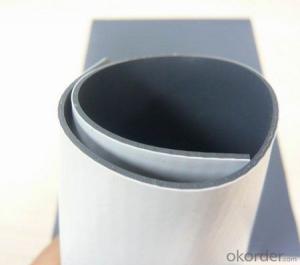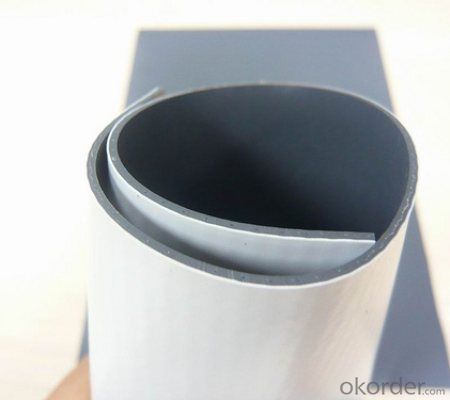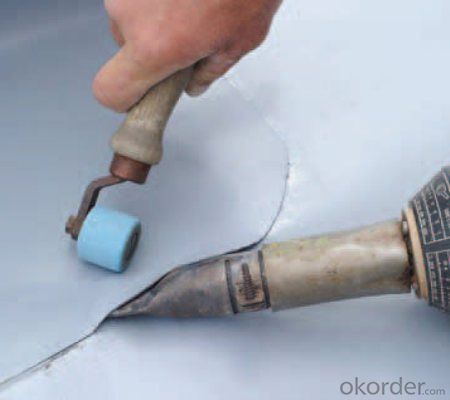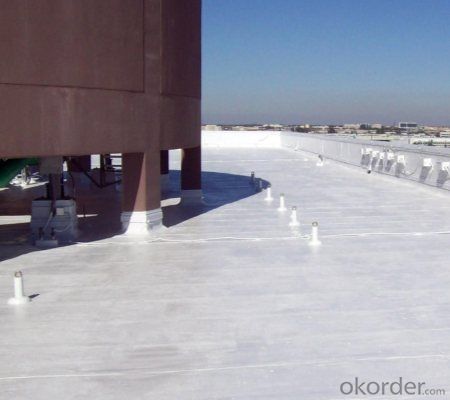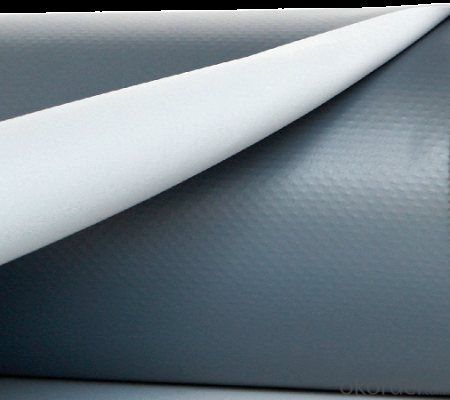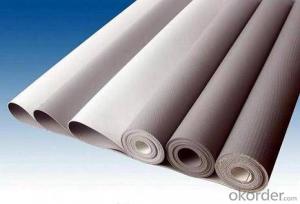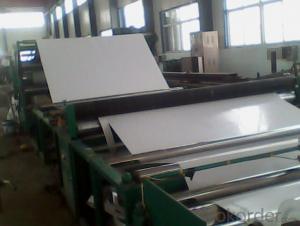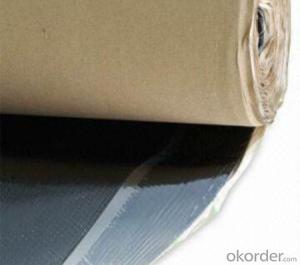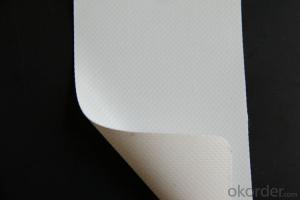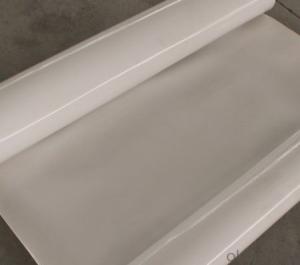PVC Membrane Smooth for Waterproof System
- Loading Port:
- Qingdao
- Payment Terms:
- TT or LC
- Min Order Qty:
- 10000 m²
- Supply Capability:
- 100000 m²/month
OKorder Service Pledge
OKorder Financial Service
You Might Also Like
PVC Membrane Smooth for Waterproof System
Description Of PVC Membrane Smooth for Waterproof System:
1. PVC Membrane Smooth is made from PVC and poliester , which is for waterproofing of exposed and non-exposed applications.
2. PVC Membrane Smooth adopts the world-advanced equipment of cold feeding extrusion and continuous vulcanization technology.
3. PVC Membrane Smooth is of high elasticity among high polymer waterproof materials and becomes a world-popular waterproofing material.
Main Features of PVC Membrane Smooth for Waterproof System:
1. Excellent physical and mechanical performance
2. High tearing resistance
3. Good deformation adaptability
4. High puncture resistance
5. High aging resistance
6. UV resistance
Specifications of PVC Membrane Smooth for Waterproof System:
Material | PVC |
Size | 1.2m (width)*20m (length) or customized, weldable type 2.05m |
Thick | 1.2mm, 1.5mm, |
Type | Smooth |
Pattern | Non-reinforced (homogeneous) |
Certificate | ISO9001/14001 |
Applications of PVC Membrane Smooth for Waterproof System:
1.Roofs, Basement, Toilets
2. Industrial and civil building waterproofing
3. Geosynthetic liner for swimming pool, channels, irrigation system
IMages of PVC Membrane Smooth for Waterproof System:


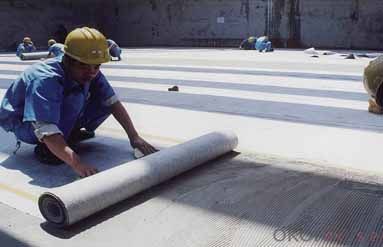
FAQ:
1. What are we supplying?
We are specialized in producing Colorful Asphalt Roof Shingle, SBS/APP modified bitumen waterproof membrane, Self adhesive bitumen waterproof membrane, PVC waterproofing membrane, EPDM rubber roofing membrane, Single Component Polyurethane Waterproof Coating, and Spray Polyurea Waterproof Coating
.
2. How Many years experience do we have?
We have been exported to more than 15 countries in the past 10 years.
3. How long do we usually reply your request?
We always reply our customer within 12 hours.
- Q: Can a waterproofing membrane be applied to existing structures or is it only suitable for new construction?
- Yes, a waterproofing membrane can be applied to existing structures as well as new construction. Waterproofing membranes are designed to provide a protective barrier against water penetration and can be used to prevent water damage in various applications such as roofs, basements, and foundations. Whether it is an old building or a new one, applying a waterproofing membrane can help to keep the structure dry and prevent moisture-related issues such as leaks, seepage, and mold growth. However, the process of applying a waterproofing membrane to an existing structure might require additional preparation and surface treatment to ensure proper adhesion and effectiveness. It is recommended to consult with a professional waterproofing contractor who can assess the specific needs of the structure and provide appropriate solutions.
- Q: Can a waterproofing membrane be used on concrete?
- Yes, a waterproofing membrane can be used on concrete. It is a common practice to use waterproofing membranes to protect concrete structures from water damage and moisture penetration. These membranes provide a barrier that prevents water from seeping into the concrete, thereby increasing its durability and lifespan.
- Q: Can a waterproofing membrane be used for swimming pools and water features?
- Yes, a waterproofing membrane can be used for swimming pools and water features. Waterproofing membranes are designed to create a barrier that prevents water from seeping through surfaces. They are commonly used in various applications, including swimming pools and water features, to ensure that the water remains contained within the designated area. These membranes are typically made from materials that are resistant to water damage and can withstand constant exposure to moisture. Additionally, they are often flexible, allowing for easy installation and adaptation to different shapes and sizes of pools and water features. Overall, using a waterproofing membrane is an effective and reliable solution to ensure the integrity and longevity of swimming pools and water features.
- Q: What kind of waterproofing membrane, waterproofing membrane is how to classify their respective advantages?
- TPO waterproofing membrane: strictly speaking TPO waterproofing membrane is EPDM (EPDM) and PVC combination, most of the performance are lower than EPDM.
- Q: How does a waterproofing membrane handle hydrostatic pressure?
- A waterproofing membrane handles hydrostatic pressure by creating a barrier that prevents water from penetrating through it. It is designed to withstand the pressure exerted by water, ensuring that it remains intact and prevents any leakage or seepage.
- Q: Can waterproofing membranes be used on concrete planters?
- Yes, waterproofing membranes can be used on concrete planters. Waterproofing membranes are designed to create a barrier against water, preventing it from seeping through the concrete and causing damage. By applying a waterproofing membrane to the concrete planter, you can ensure that the planter remains watertight, preventing water from leaking out and potentially damaging the surrounding area. This can be especially beneficial for planters located indoors or in areas where water leakage could cause structural damage or create a mess. Additionally, waterproofing membranes can also help protect the concrete from freeze-thaw cycles, which can cause cracking and deterioration over time. Overall, by using waterproofing membranes on concrete planters, you can extend their lifespan and maintain their functionality for a longer period of time.
- Q: Can a waterproofing membrane be used for a deck?
- Yes, a waterproofing membrane can be used for a deck. It provides an effective barrier against water and protects the underlying structure from moisture damage.
- Q: Does a waterproofing membrane have any fire resistance properties?
- No, a waterproofing membrane typically does not have any fire resistance properties. The main purpose of a waterproofing membrane is to provide a barrier against water infiltration and protect the underlying structure from moisture damage. Fire resistance, on the other hand, refers to a material's ability to withstand fire or reduce the spread of flames. Fire resistance properties are typically found in specialized fireproofing materials or coatings, which are designed to prevent the spread of fire and protect the structure in case of a fire incident. It is important to consider both fire resistance and waterproofing requirements when selecting materials for construction projects, as they serve different purposes and may require separate measures to ensure safety.
- Q: What is rigid waterproof, flexible waterproof?
- 1, rigid waterproof means that: waterproof layer by the tensile force is greater than the tensile strength of waterproof materials (including settlement deformation, temperature deformation, etc.), waterproof layer of brittle cracking caused by leakage of water, known as rigid waterproof. (Especially the "water leakage" waterproof layer), waterproof concrete mortar waterproof layer, thin layer of inorganic rigid waterproof layer (such as "water leakage" waterproof layer), and so on.
- Q: Can a waterproofing membrane be used on foam block surfaces?
- Yes, a waterproofing membrane can be used on foam block surfaces. The membrane acts as a protective barrier, preventing water penetration and ensuring the foam blocks remain waterproof.
Send your message to us
PVC Membrane Smooth for Waterproof System
- Loading Port:
- Qingdao
- Payment Terms:
- TT or LC
- Min Order Qty:
- 10000 m²
- Supply Capability:
- 100000 m²/month
OKorder Service Pledge
OKorder Financial Service
Similar products
Hot products
Hot Searches
Related keywords
